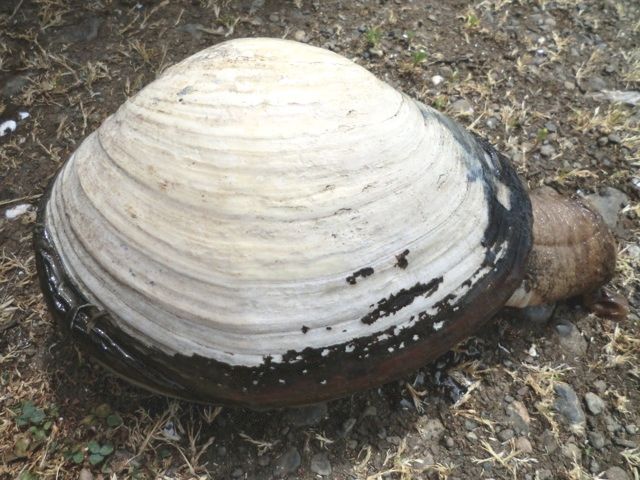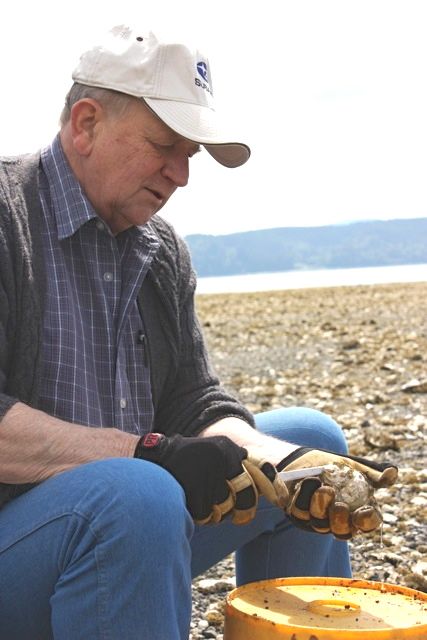
reference-image, l
(article, Spencer Adrian)
[%pageBreakSettings nobreak=true] [%adInjectionSettings noInject=true] A row of RVs, worn by years of sunshine and salty sea air. People on the beach below, digging for oysters and clams. Crab boats floating just offshore, tied to brightly colored buoys. [[block(sidebar). h1.Featured recipes]] My grandparents have brought me here since before I could walk. Throughout my childhood, Mike’s Beach Resort on Washington's Hood Canal was my summer home. Every night, we prepared crab and fresh oysters for dinner and watched the campfire as the sun went down over the waters of Puget Sound. As I grew older, the generation that stayed here to crab and fish and hunt for oysters grew older too. Faces became wrinkled from years of living on the water. Beach walks got slower. Arthritic hands made pulling up crab pots from the deep an unthinkable task. Each year, more couples from my grandparents' generation pack up and leave Mike’s Beach for the last time. With them vanishes their tricks for digging up clams, their secret spots for catching shrimp. New, younger families are beginning to move in; they prefer speed boats and Jet Skis, scuba diving and iPhones. [%image grandma float=left width=350 caption="The author's grandmother, Ann Visser, digging for Manila clams on Hood Canal in 2009."] On one of my last trips to Hood Canal with my grandparents, we decided to make our way down to the beach and gather some food for dinner. I wandered toward the water’s edge, my feet crunching the thousands of oyster shells that littered the beach. Small red crabs skittered out from under rocks, hoping to find a new home before the tide enveloped them once again. I eyed the water's edge. Somewhere near there, buried deep under the rocks and sand, was my prize. Behind me, my grandfather sat on an overturned five-gallon bucket. Even with callused hands swollen from arthritis, he shucked oysters with incredible precision and finesse. To his left, my grandmother raked up small Manila clams by the handful. Even in old age, she moved quickly with a trained eye, scooping up the biggest clams for dinner and covering the rest back up so they could continue to grow. My grandparents have come to this beach every summer for the last 40 years. They have learned the ins and outs of the water, as well as how to shrimp, crab, collect oysters, fish, and dig for clams. They have become local experts, learning that the Manilas, for example, like to live in areas with less rock, or that most crab live in 75 feet of water. While they gathered oysters and clams, I searched for a bigger bounty: the geoduck. A Pacific Northwest delicacy, the geoduck (pronounced "gooey-duck") certainly doesn't look delicate; it is one of the biggest clams around, with a shell some 8 inches long and a thick, muscular siphon (the clam's "neck") that can reach an astonishing three feet long. It has a slightly sweet flavor and, when cooked properly, an almost buttery texture. [%image reference-image float=right width=400 caption="Not a geoduck but a horse clam."] I’ve pulled crab and shrimp up from the depths, shucked more than my fair share of oysters, and dug up plenty of smaller clams, but the mighty geoduck had always eluded me. Finding one today, I had decided, would prove to my grandparents that their knowledge wasn’t being lost, and that someday I could fill their clamming shoes. My grandpa has a knack for finding geoducks, and as a kid I'd watch, fascinated, as he pulled monster geoducks out of holes that could run three feet deep. “They are hard to find,” my grandpa always told me. “You need patience, a keen eye, and to be quick with your shovel.” With an incoming tide, and my grandpa’s wisdom in my mind, I began to scan the water’s edge for the quarter-size hole the geoduck uses to catch its food. This might be my last opportunity to find a geoduck with my grandparents, and I was determined. [%image grandpa float=left width=350 caption="The author's grandfather, Hans Visser, shucking oysters at Hood Canal in 2009."] A bald eagle flashed past me, just a few feet above the water, a small fish struggling between its massive talons. I looked back down at the sand, and saw a small, quarter-sized hole. “I found one!” I yelled with childish excitement, and grabbed the shovel. Once a geoduck senses danger, it will retreat deep into its hole, anywhere from two to five feet below the surface. I knew that I was in for a fight. As I dug, water began to refill the hole. In the mix of sand and murky water, I caught a glimpse of a clamshell. I dropped to my knees and began to sift through the hole with my hands until I could grab the monstrous clam. Barely able to hold onto it with one hand, I spun around to show my grandparents. My grandpa stood only halfway down the beach, hand on his sore hip. “That’s a horse clam,” he laughed, and turned around to gather up his oysters. I sat back on the beach, my heart sagging. Upon closer inspection, this clam was indeed smaller and more rounded than a geoduck. The hole I had just ferociously dug had disappeared under the incoming tide. I had failed. My grandma kneeled next to me and turned the horse clam over in her hands. She gave me a hug, the kind that only grandmas can give, and then picked up my shovel. “We can still use it,” she said. “Let’s go back to the trailer, and I’ll show you how to prepare it for clam chowder.” p(bio). Spencer Adrian is an Oregon native studying journalism and advertising at the University of Oregon. In an attempt to find the hidden connections between culture and food, he runs a blog titled [roadsandreststops.wordpress.com "Roads and Rest Stops" newpage=true]. Find him on twitter @spenceadrian.

reference-image, l

grandma, l

grandpa, l